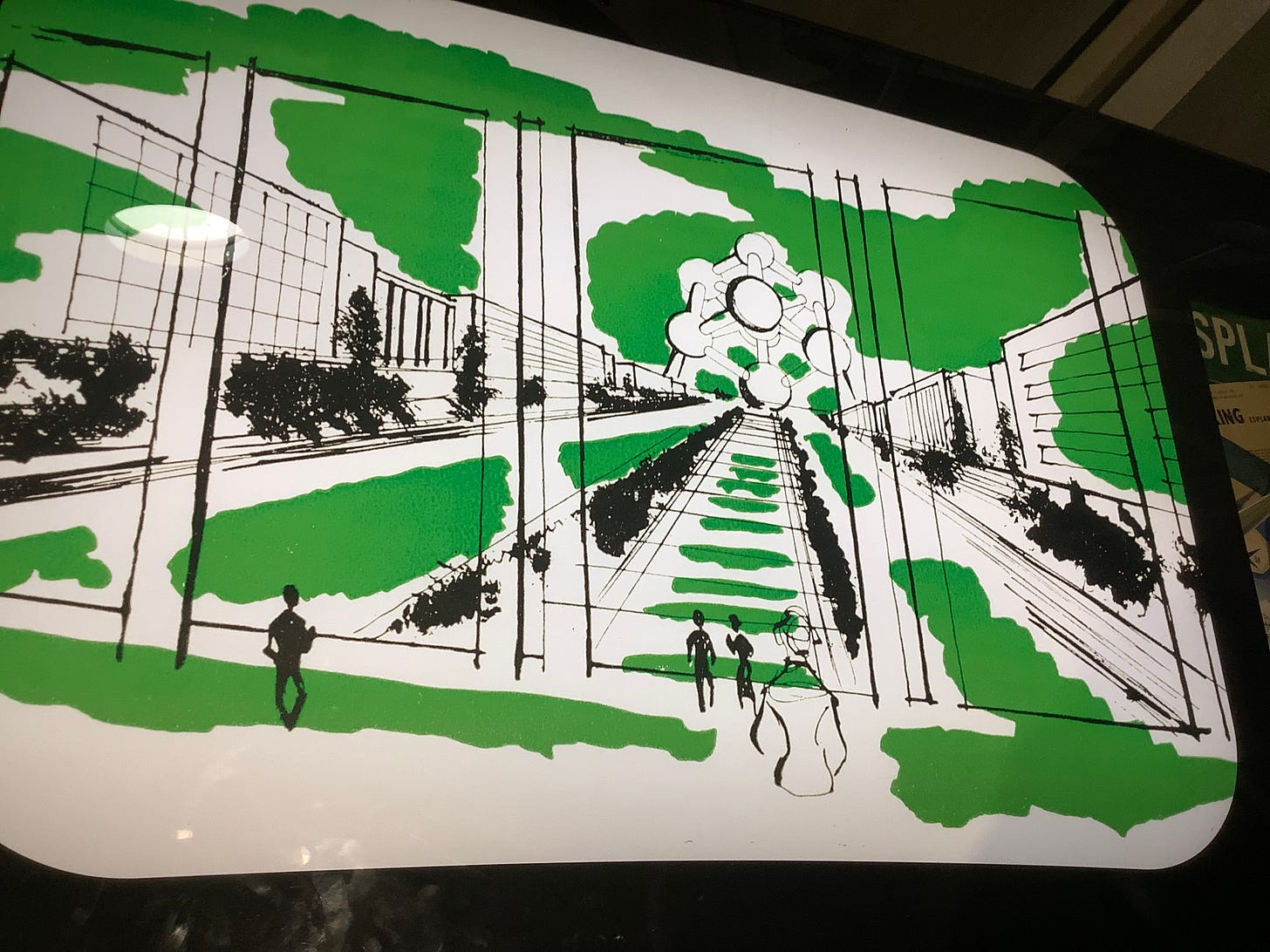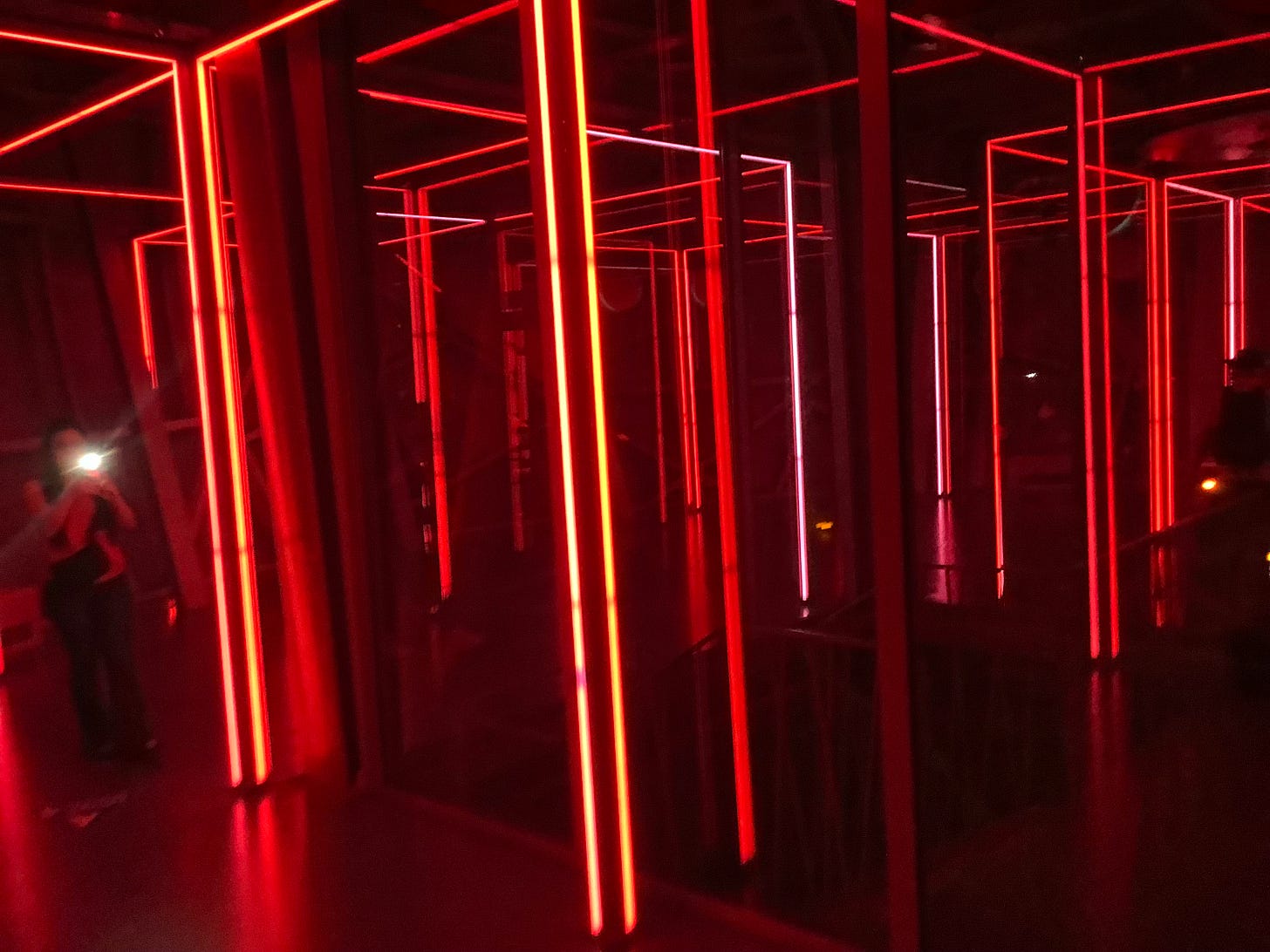22 August 2022. Modernity | Work
The idea of the ‘modern’ and the idea of the future // ‘People don’t want to work’
Welcome to Just Two Things, which I try to publish daily, five days a week. Some links may also appear on my blog from time to time. Links to the main articles are in cross-heads as well as the story. A reminder that if you don’t see Just Two Things in your inbox, it might have been routed to your spam filter.
I’m on a break for a while so won’t be producing Just Two Things regularly during that time. But there will be a couple of editions, since there are some things I’m trying to catch up on.
1: Building the idea of the modern
The website paleofuture.com used to write about ideas that seemed futuristic at the time they were written, so it naturally came to mind during a visit to the Atomium in Brussels. The Atomium is a scale model of an iron crystal, scaled to 165 billion times the size of an actual atom. It was built as the central idea of the 1958 Expo.
(All photos Andrew Curry, CC BY-NC-SA 4.0)
The dropping of the atomic bombs on Hiroshima and Nagasaki was still a fresh memory in 1958, and so the “atomic” theme needed an alibi—and used the idea of “atoms for peace” being promoted at the time by the US Eisenhower administration.
The Americans must have been delighted by this, since the whole Atoms for Peace programme was part of its Cold War strategy at the time.
The purpose of the Expo—the World’s Fair—in 1958 and historically, was to project modernity, both generally and for the host country. Belgium had just become a member of the fledgling European Economic Community, and its industries were still recovering from the second world war.
The website records that:
With the slogan ’a world for a better life for mankind’, Expo 58 wanted to be an expression of the democratic will to maintain peace among all nations, of faith in both technical and scientific progress and, finally, an optimistic vision of the future of the new, modern and hyper-technological world that should enable mankind to live better lives.
Construction was definitely old school. A film in the on-site exhibition shows the thousands of bolts that held the structure together being tightened with hand tools.
You take your signifiers of modernity where you find them. The Atomium was clad in aluminium (now replaced), but then the idea of a new lightweight industrialism. The Expo hostesses were kitted out to look like airline stewardesses, at the time pretty much the most glamorous technology-enabled job on the planet.
The atom theme, or maybe the views from the top, struck a chord with the public. 41 million people visited during the six months of the Expo. The structure was supposed to stand for six months, but stayed up by popular demand.
The Expo was also designed to promote ‘modern’ economic development in north Brussels. The location of the site was connected to new roads, an airport was constructed nearby, and a significant amount of new housing was constructed in the area.
The 1958 exhibition hosted an exhibition on the theme of atomic energy. These days, after a period in the early 2000s where it was threatened with demolition but then refurbished, it has an exhibition in the lower floor on the building and the 1958 Expo, and rotating exhibitions above that. When we visited in July, there was a light and music show, and an online pandemic project started by a Belgian that celebrated global connectedness.
A visit to the Atomium comes with admission to the nearby Design Museum. Its permanent exhibition is a history of design using plastic. It does this with a nod to itself—the famous clip from The Graduate runs at the entrance.
The overwhelming effect is of designers throwing off the shackles of conventional design and enjoying the freedom offered by the material. For one thing, the gallery is awash with colour.
With hindsight, of course, we know that plastic everywhere is a curse as well as a helpmate. We are still waiting for the enzymes that can break down plastics at scale, as it works its way deep into our biological and ecosystems.
Nuclear power, similarly: how do we tell people or creatures 10,000 years hence how to avoid the radioactive waste?
The “unintended consequences” argument about technologies is an easy one to have, although the discussion about the precautionary principle is one for another time.
I’m more interested here in the effect of both the atom and plastics in the 1950s and 1960s on ideas about the future. The idea of ‘Atoms for Peace’ seems cynical in hindsight, but—like the bright new designs in plastic—it conveyed the idea that the future was going to be better than the past.
(US Post Office, Bureau of Engrving and Printing, 1955. Public Domain)
For whatever reason, the technologies we associate with renewables don’t conjure a big idea about a better future, even though they should. Wind turbines should create the same excitement as the promise of the electricity grid did in the 1930s, or the promise of cheap nuclear energy did in the 1950s. (And here’s Spender’s poem about electricity pylons, with its idea of “the quick perspective of the future.”). Instead, they get embroiled in NIMBYist dogfighting.
Similarly things that ought to feel like a better future—a shorter working week, or better psychological health—don’t seem to register as a positive future change. Perhaps as a species we’re not very good at abstraction, at least when it comes to thinking about better futures.
2: ‘People don’t want to work’
I see that that the candidates for the leadership of Britain’s Conservative Party have been trying to out-do each other on the theme that the British worker doesn’t work hard enough.
Paul Fairie, who from time to time assembles on Twitter examples of such familiar tosh going back over the decades (in his case typically American examples) recently assembled a century of newspaper reports on the theme that ‘nobody wants to work anymore’.
That’s the 2022 version.
Here’s the example from 1894:
The examples in between can be seen on this ThreadReader link.
In case you’re wondering on the veracity of these, someone has also taken the trouble to pull together a list of sources:


Thanks to Peter Curry for the link. And if you’re on Twitter, do follow Paul Fairie (@paulisci).
——————————-
j2t#364
If you are enjoying Just Two Things, please do send it on to a friend or colleague.












